
Note: AP®, Advanced Placement® and College Board® are trademarks registered by the College Board, which is not affiliated with, and does not endorse, this website.
It’s May 7, 2019 and you’re sitting in your school’s gymnasium with desks spaced six feet apart. You’ve got a school issued laptop or iPad on your desk, with a headset and microphone, as well as a pencil, eraser, and exam booklet. At 8:00 am sharp the exam proctor announces you may open your exam booklet. Are you ready for the Advanced Placement® Spanish Language and Culture exam?
The AP® Spanish Language and Cultural exam is the most popular AP world language exam, with good reason — there are six million students studying Spanish in school in the United States. With about 50 million Spanish-speakers, the U.S. is the second largest Spanish speaking population in the world after Mexico. Speaking Spanish is great for people who love to travel – it’s the official language in 20 countries. And learning Spanish can help students understand another culture, boost career opportunities, and more.
In this post, we’ll demystify the AP Spanish Language and Culture exam, give an overview of AP exams, take a thorough look at each section of the AP Spanish exam and offer plenty of tips for how to prepare for the AP Spanish exam so you can get your best grade. Along the way, we’ll share expert advice from PandaTree tutors and advisors who have helped The College Board develop and grade AP exams in the past.
A Primer on AP Exams
What are AP exams, and why should students take them?
Advanced Placement (AP) Exams are standardized exams developed by The College Board (the educational body which also administers the SAT test). Administered in the U.S. and Canada, AP exams test a student’s knowledge of college-level curricula. High school AP courses are designed to prepared students for the AP exam towards the end of the year and the exam is a standardized way to confirm a student’s mastery of a given subject.
Why should a student take AP courses and AP exams?
High school students should consider taking AP courses and exams for two key reasons: first, admissions boards of competitive universities like to see high AP scores on student transcripts — it demonstrates that a student is prepared to succeed in college-level academic courses. Second, high scores on AP exams often count as college credit, depending on the university’s policies. In addition, 35 states now participate in the Seal of Biliteracy program and award students special recognition on their high school diploma. Criteria for qualifying for the seal differ by state, but often a high score on an AP test can qualify the students.
How are AP tests scored? Who grades them?
All AP test takers are scored on a scale from 1 to 5, with 1 meaning “no recommendation” and 5 being “extremely well qualified” — the highest score a student can earn. AP tests are scored by graders, called “readers” hired by the College Board, in order to ensure that the grades are consistently calibrated. AP readers are selected from high school AP teachers and college instructors and they attend “AP Reading Week” in June, when all AP exams are graded.
Intro to the AP Spanish Language and Culture Exam
How popular is the AP Spanish Language and Culture Exam?
The AP Spanish Language and Culture exam is the most popular AP world language exam — more than 180,000 students took the AP Spanish exam in 2018, a 33% increase from 2014. In 2018, exam-takers included 59,000 Standard Students, who self-report that they do not speak or hear Spanish at home regularly, and have not lived in a Spanish-speaking country for a month or more.
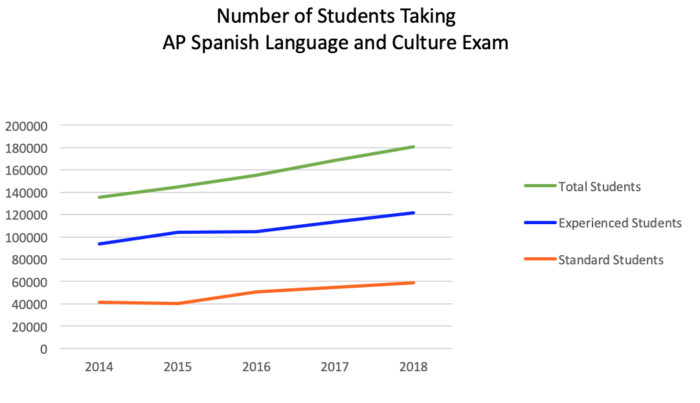
Source: The College Board
When is the AP Spanish Language and Culture test administered? How much does the exam cost?
Most AP exams are administered during a two-week stretch in May each year, after a high school student has completed two semesters of AP course study in the subject. This year, the AP Spanish Language and Culture Exam falls on Tuesday, May 7, 2019 at 8:00 am local time.
In 2019, AP exams cost $94 per test. Students and their families may qualify for AP exam fee reductions and federal and state assistance.
What does the AP Spanish Language and Culture exam test for? How long is it?
The AP Spanish test will test students’ proficiencies in the interpersonal, interpretive and presentational modes of communication — reading, writing, and speaking. Students have approximately 3 hours minutes to complete the AP Spanish Language and Culture exam.
How is the AP Spanish exam administered? How do test takers submit spoken responses?
The first and part of the second portion of the AP Spanish exam is administered traditionally — students answer with multiple choice selection or written responses. In the last portion however, students are asked to record spoken answers to given prompts through AP’s Digital Audio Submission (DAS) portal. The portal is accessed through school-provided computers or recording devices, and most recently, a Digital Audio Capture (DAC) app has been made available for Apple iPad tablets.
What are the components of the AP Spanish Language and Culture Exam?
The AP Spanish test consists of 4 distinct portions which cover skills in listening, reading, writing and speaking. The exam is approximately 3 hours long and includes a 95-minute multiple choice section and an 85-minute free-response section.
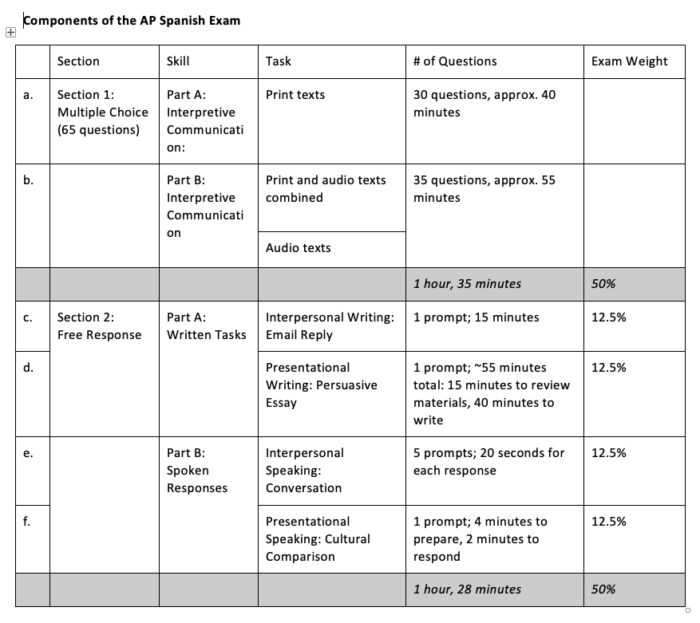
Source: The College Board
How Well Do Students Do on the AP Spanish Language and Culture Exam?
Each year, the AP College Board releases score distributions, displayed as the Total Group and the Standard Group. While the Total Group reflects the score distribution for all test-takers, the Standard Group does not include students who hear or speak Spanish at home, or who have lived for one month or more in a country where Spanish is the native language. Unless your student regularly hears Spanish at home, the Standard Group is the best comparison.
The data from the College Board show that amongst the Total Group 23.7% of exam takers scored a 5 in 2018. Amongst the Standard Group, 16.5% of students scored a 5.
Scoring a 5 on the exam is similar to earning an A on a college-level Spanish course or Advanced level proficiency on the American Council for the Teaching of Foreign Languages (ACTFL) proficiency scale.
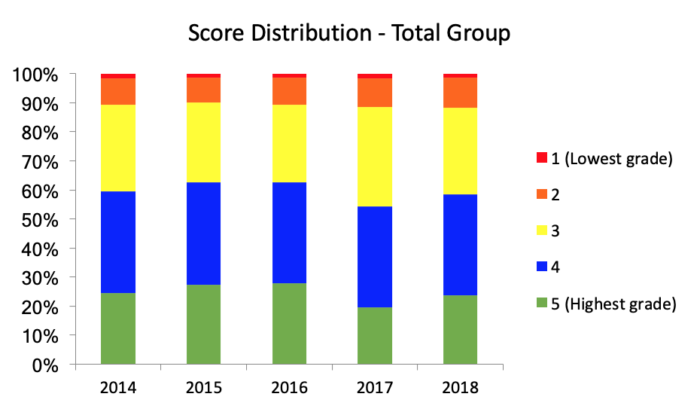
Data Source: The College Board
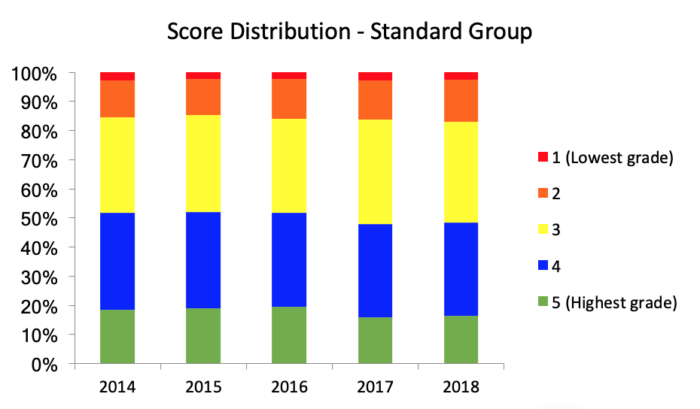
Data Source: The College Board
The College Board also shares data on the scores for the four Free Response questions in Section 2 (but not the Multiple Choice questions in Section 1.)
The data shows that amongst the Total Group, scores were usually slightly lower for the presentational tasks versus the interpersonal tasks. In 3 out of 4 years, presentational writing (the persuasive essay) scored lower than interpersonal writing (responding to an email). In all years, presentational speaking (cultural comparison presentation) scored lower than the interpersonal speaking (conversation) – which had the highest scores of all the free response questions in each year.
For the Standard Group, which excludes students who hear or speak Spanish at home, or who have lived for one month or more in a country where Spanish is the native language – scores tended to be slightly lower than for the Total Group, and the scores for each of the four questions were similar. The exception was the 2017 Presentational Speaking question, which scored significantly lower than other questions. The question that year asked how the media affected the development of people’s personal image. Some students appear to have misinterpreted the phrase “los medios de comunicación” as modes of communication rather than the media.
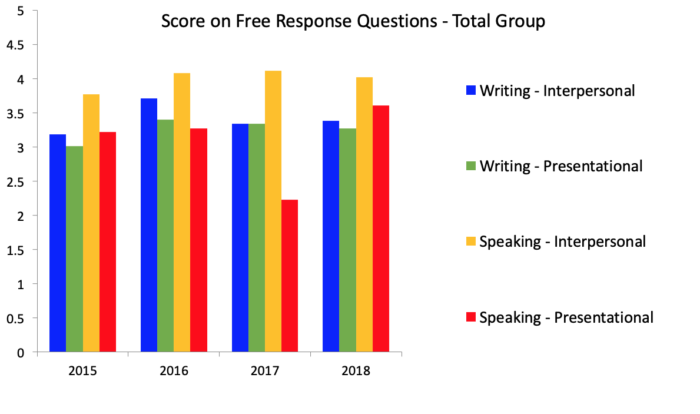
Data Source: The College Board
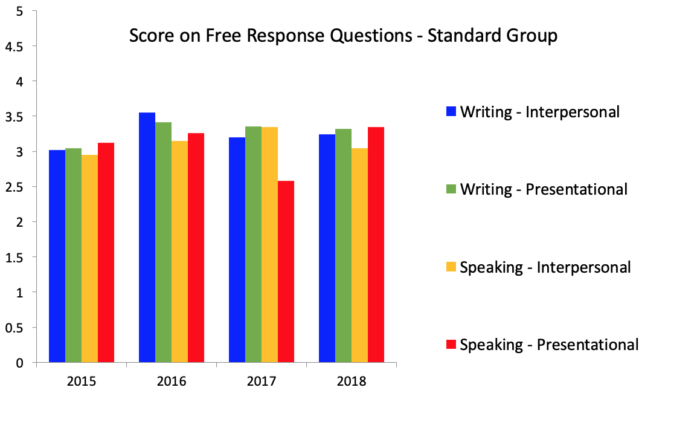
Data Source: The College Board
Deep Dive on Each Question Type
Being ready for the AP Spanish exam includes understanding what each different section of the exam is looking for. Here we’ll go into detail about each question type, and offer tips for maximizing your score.
a. Section 1 Multiple Choice – Part A Interpretive Communication of Print Texts
Question instructions: According to the College Board: “You will read several selections. Each selection is accompanied by a number of questions. For each question, choose the response that is best according to the selection and mark your answer on your answer sheet.”
What to expect: You’ll be provided multiple authentic print texts — which could be a journalistic or literary text, announcement, public service announcement, advertisement, letter, map or table. You’ll read through the print text and then answer a total 30 questions about the print texts. Past topics have included leisure activities, demographics and population growth.
How to maximize your score: The multiple choice section is straightforward in this regard — exam-takers should read carefully, and choose whichever answer seems most appropriate to them, and move on. Don’t gets hung up on a question. Instead, move on, completing the rest of the questions, and come back to any you’re stuck on. Points are not subtracted for incorrect answers, so it is better to guess than leave a question unanswered.
b. Section 1 Multiple Choice – Interpretive Communication of Print Text and Audio Texts
Question instructions: According to the College Board: “You will listen to several audio selections. The first two audio selections are accompanied by reading selections. When there is a reading selection, you will have a designated amount of time to read it. For each audio selection, first you will have a designated amount of time to read a preview of the selection as well as to skim the questions that you will be asked. Each selection will be played twice. As you listen to each selection, you may take notes. Your notes will not be scored. After listening to each selection the first time, you will have 1 minute to begin answering the questions; after listening to each selection the second time, you will have 15 seconds per question to finish answering the questions. For each question, choose the response that is best according to the audio and/or reading selection and mark your answer on your answer sheet.”
What to expect This section is similar to the previous section except with an added listening component. Each audio selection will be played twice — take advantage of the repetition. The two parts of this section are an article and audio on the same topic followed by a chart and conversation.
How to maximize your score: It’s crucial to have practiced listening to and interpreting authentic Spanish texts and audio selections in order to do well on this section — comb through previous exams and practice, practice, practice. Remember that you will hear each audio selection twice: feel free to take notes and spend the second listening trying to hone in on elements you may have missed from the first just don’t let note taking cause you to miss the main ideas. Prepare for this by regularly listening to and reading Spanish-language newspapers, news reports, and podcasts. BBC Mundo and El País are great options.
c. Section 2, Part A, Interpersonal Writing: Email Reply
Question instructions: According to the College Board: “You will write a reply to an email message. You have 15 minutes to read the message and write your reply. Your reply should include a greeting and a closing and should respond to all the questions and requests in the message. In your reply, you should also ask for more details about something mentioned in the message. Also, you should use a formal form of address.”
What to expect: You’ll write as though you are the recipient of the email provided to you, and be asked to exchange information, opinions and ideas. understand and use a wide variety of vocabulary including idiomatic and culturally appropriate expressions on a variety of topics. Past topics have included designing an app, applying for a long-distance education, sponsoring an animal shelter, applying for a scholarship to study in a different country, and being part of an environmental group.
- Providing input for the development of a mobile travel app, including why the student is interested in traveling abroad and what type of information they need to plan their itinerary. (2018)
- Writing to the admissions office of a university, explaining why they were considering long-distance learning, and what challenges they might face. (2017)
- Responding to an email from an animal shelter and answering why they were interested in making a donation and what animal they would like to shelter and why. (2016)
- Responding to an email as a finalist for a scholarship to Peru and answering questions about what difficulties they might have living abroad and what impact it would have on their future. (2015)
How to maximize your score:
According to the College Board, answers that score a 5 demonstrate the following:
- Maintains the exchange with a response that is clearly appropriate within the context of the task
- Provides required information (responses to questions, request for details) with frequent elaboration
- Fully understandable, with ease and clarity of expression; occasional errors do not impede comprehensibility
- Varied and appropriate vocabulary and idiomatic language
- Accuracy and variety in grammar, syntax, and usage, with few errors
- Mostly consistent use of register appropriate for the situation; control of cultural conventions appropriate for formal correspondence (e.g., greeting, closing), despite occasional errors
- Variety of simple and compound sentences, and some complex sentences
According to the Chief Reader’s reports, in the past, when students have struggled it is because:
- They misunderstood the prompt. For example some students interpreted “aplicación” to mean a job application rather than an app on the 2018 exam, or interpreted “educación a distancia” to mean studying abroad instead of online courses on the 2017 exam, or thought they were being asked to work at an animal shelter rather than make a donation on the 2016 exam, or they didn’t understand that they were a finalist for a scholarship “beca” on the 2015 exam.
- They had inconsistent use of the formal register (e.g. tú v. usted),
- They didn’t address all the questions and requirements of the prompt.
PandaTree Tutor and AP Teacher, Elise Plaza, who has graded AP exams for the College Board for 6 years, recommends: “As students prepare to answer the email prompt, they should circle all the requirements in the prompt, and check them off as they complete them. Don’t forget that in addition to responding fully to all the parts of the questions in the email you should also include your own questions asking for additional information. In addition, include a greeting and a closing in your email, but don’t simply repeat the salutations used in the prompt.”
d. Section 2, Presentation Writing: Persuasive Essay
Question instructions: According to the College Board “You will write a persuasive essay to submit to a Spanish writing contest. The essay topic is based on three accompanying sources, which present different viewpoints on the topic and include both print and audio material. First, you will have 6 minutes to read the essay topic and the printed material. Afterward, you will hear the audio material twice; you should take notes while you listen. Then, you will have 40 minutes to prepare and write your essay. In your persuasive essay, you should present the sources’ different viewpoints on the topic and also clearly indicate your own viewpoint and defend it thoroughly. Use information from all of the sources to support your essay. As you refer to the sources, identify them appropriately. Also, organize your essay into clear paragraphs.”
What to expect: Past topics have included:
- Whether traditional libraries will be relevant in the future. (2018)
- Whether students should be allowed to use cellular phones in high school. (2017)
- Whether the increasing popularity of digital books is good. (2016)
- Whether it’s beneficial for companies to let employees work from home. (2015)
Sources have frequently been newspaper or magazine articles from the Spanish-speaking world, authentic charts, and audio interviews or news reports.
How to maximize your score: According to the College Board’s grading rubric, responses that scored a 5 demonstrated the following:
- Effective treatment of topic within the context of the task
- Demonstrates a high degree of comprehension of the sources’ viewpoints, with very few minor inaccuracies
- Integrates content from all three sources in support of the essay
- Presents and defends the student’s own viewpoint on the topic with a high degree of clarity; develops a persuasive argument with coherence and detail
- Organized essay; effective use of transitional elements or cohesive devices
- Fully understandable, with ease and clarity of expression; occasional errors do not impede comprehensibility
- Varied and appropriate vocabulary and idiomatic language
- Accuracy and variety in grammar, syntax, and usage, with few errors
- Develops paragraph-length discourse with a variety of simple and compound sentences, and some complex sentences
While there is not guidance on how long the student’s persuasive essay should be, responses that score a 5 are typically 2 to 2-1/2 pages of handwritten single-spaced text.
According to the Chief Reader’s report, essays that struggled often didn’t include supporting evidence from all 3 of the sources. In addition, students should be sure to integrate information from the source in support of their argument, rather than just summarize the source, and should include more than one idea from each source. Occasionally students misunderstood the prompt, for example addressing why cell phones should or should not be used in classes rather than in school overall, which was the question (2017).
According to Dimaris Barrios-Beltran, a PandaTree AP tutor who has graded AP exams for 4 years and a table leader for 2 years: “When using the sources, the most important thing is to show that the student understood each of the sources and that they are integrated and follow a logical order of discussion. The student has the option of defending the idea, refuting it or explaining the pros and cons, but it is highly important to refer to the sources to substantiate their argument with evidence.”

While the College Board says there is no single format that is acceptable for referring to the three sources, Ken Stewart, a PandaTree advisor, who has previously helped the College Board develop AP Spanish exams, says: “It is good practice for students to use MLA style citations, with the author’s or publisher’s name in brackets, or if that is unknown, then a shortened title after each quote or reference.” The source, in brackets, should be included before the period of the sentence.
e. Section 2, Interpersonal Speaking: Conversation
Question instructions: According to the College Board: “You will participate in a conversation. First, you will have 1 minute to read a preview of the conversation, including an outline of each turn in the conversation. Afterward, the conversation will begin, following the outline. Each time it is your turn to speak, you will have 20 seconds to record your response. You should participate in the conversation as fully and appropriately as possible.”
What to expect: You’ll be given the written outline in Spanish of a conversation. The outline describes who you are talking with, and what each speaker does each time they speak. For example, “answer in the negative and explain why.” You only have one minute to digest the outline before you’ll hear the first conversation prompt on your audio device. Someone else will speak, you’ll hear a tone, and then you’ll have 20 seconds to record your response. Expect to speak 5 or 6 times, responding to different prompts as the conversation evolves.
Past conversations have included topics such as: updating a classmate about a meeting she missed with academic advisors about universities (2018), discusssing with a classmate a school project to create a website (2017), discuss community volunteering events with a friend (2016),
How to maximize your score: According to the College Board, answers that earned a 5 have the following qualities:
- Maintains the exchange with a series of responses that is clearly appropriate within the context of the task.
- Provides required information (e.g., responses to questions, statement and support of opinion) with frequent elaboration.
- Fully understandable, with ease and clarity of expression; occasional errors do not impede comprehensibility.
- Varied and appropriate vocabulary and idiomatic language.
- Accuracy and variety in grammar, syntax, and usage, with few errors.
- Mostly consistent use of register appropriate for the conversation.
- Pronunciation, intonation, and pacing make the response comprehensible; errors do not impede comprehensibility.
- Clarification or self-correction (if present) improves comprehensibility.
According to the Chief Reader report, in some cases students did not respond to the prompt as directed in their outline. For example, in 2015 the outline asked students to respond in the negative and provide an alternative. Some students responded in the affirmative. In some cases, students only answered part of the question in the prompt. In 2016, as the final question, students were asked if they had any questions, and some students did not expect to have to come up with their own question about the topic.

According to Barrios-Beltros, “the best way to prepare for this task is to practice, practice and practice. Look for friends, teachers, family members and tutors with whom you can have conversations in Spanish. The focus should be to improve your pronunciation and to feel comfortable answering unexpected questions from a peer. You can start with a topic like: organizing a party; choosing a place to eat; or buying tickets for a concert. Then, you start asking each other different questions about the event or activity that you are planning to execute. Keep answers simple but logical and coherent – and remember to keep talking. You can use phrases like: así pues, por otro lado, sin embargo, también, entonces… but avoid using umm, emm, uhhh, etc. Lastly, don’t forget we all make mistakes so feel free to self-correct when needed.”
f. Section 2, Presentational Speaking: Cultural Comparison
Question instructions: According to the College Board, “You will make an oral presentation on a specific topic to your class. You will have 4 minutes to read the presentation topic in Spanish and prepare your presentation. Then you will have 2 minutes to record your presentation. In your presentation, compare your own community to an area of the Spanish speaking world with which you are familiar. You should demonstrate your understanding of cultural features of the Spanish-speaking world. You should also organize your presentation clearly.”
What to expect: In this section, the student is asked to plan and produce spoken presentational communications, expound on familiar topics and those requiring research, and demonstrate an understanding of features of target culture communities (e.g., geographic, historical, artistic, social, and/or political). Past topics have included:
- Attitudes toward the treatment of animals in the student’s community compared to a community in the Spanish-speaking world (2018)
- The importance of the media in the development of personal image in the student’s community compared to a community in the Spanish-speaking world (2017)
- What type of events or activities are an expression of cultural identity in the student’s community compared to a community in the Spanish-speaking world (2016)
- The impact of fast food on the student’s community compared to a community in the Spanish-speaking world. (2015)
How to maximize your score: According to the College Board’s scoring rubric, students that earned a 5 demonstrated the following:
- Effective treatment of topic within the context of the task.
- Clearly compares the student’s own community with the target culture, including supporting details and relevant examples.
- Demonstrates understanding of the target culture, despite a few minor inaccuracies.
- Organized presentation; effective use of transitional elements or cohesive devices.
- Fully understandable, with ease and clarity of expression; occasional errors do not impede comprehensibility.
- Varied and appropriate vocabulary and idiomatic language.
- Accuracy and variety in grammar, syntax, and usage, with few errors.
- Mostly consistent use of register appropriate for the presentation.
- Pronunciation, intonation, and pacing make the response comprehensible; errors do not impede comprehensibility.
- Clarification or self-correction (if present) improves comprehensibility.
According to the Chief Reader’s report, in some years students haven’t fully addressed the prompt – for example, in 2017, describing a cultural activity, but not explaining how it reflects cultural identity. communities. Additionally, students should make “equal comparisons” e.g., compare a country to a country or a city to a city, and be clear about the communities they have chosen.
It goes without saying for questions like this it’s really important for students to practice prepping and saying their presentation under the 4 minute/2 minute time limits to become comfortable managing their time.
During their prep time, students should can use Venn-diagrams or t-charts to help them organize their thoughts. They should not attempt to write out their presentation in full – they just won’t have time.
Stewart, a PandaTree advisor recommends “from an organization point of view, it’s generally best to start with the community in the Spanish-speaking world for the first half of the presentation, and then compare it to the student’s community in the second half of the presentation, rather than trying to go back and forth between the two.”
Ken Stewart, who has previously helped the The College Board develop AP Spanish exams recommends that for the Cultural Comparison presentation “it is generally best to start with the community in the Spanish-speaking world for the first half of the presentation, and then compare it to the student’s community.”
PandaTree’s Barrios-Betran says, “in order to avoid over-generalizations or stereotypes avoid implying that everybody does a certain thing or thinks in a certain way by using phrases like often, in general, typically, etc. Focus on those communities or groups that you are familiar with and make specific comparisons.”
How to prepare for the AP Spanish Language and Culture exam
So now that you know the format of the AP Spanish Language and Culture exam, what are the best tips for preparing for it?
- Take the high school AP Spanish course: This course, offered in thousands of U.S. and Canadian high schools in North America, is specifically designed to prepare a student to succeed on the AP Spanish Language and Culture test.
- Practice, practice, practice: While the AP Spanish Language and Cultural test undoubtedly measures a person’s proficiency in the Spanish language, it also tests how well a student understand the test itself. When studying for the AP Spanish test, students should practice just like one would for any other standardized test (like the SAT). Complete sample exams — many are available on the College Board website. PandaTree also makes additional practice materials available for free – click here.
- Practice in realistic conditions: Can you hand-write a persuasive essay in 40 minutes? Can you record a 20 second response to a conversation prompt? Getting familiar with the timing and technology is important prep.
- Practice Spanish language skills with PandraTree tutors: PandaTree offers one-on-one tutoring with AP-experienced teachers, many of whom have graded AP Spanish exams for the College Board. Prior to the lesson, students can complete a practice section of the test, which their tutor will grade. During the one-on-one lesson, the tutor will provides feedback and coaching. This expert feedback allows a student to zero in on key areas for improvement and accelerates student progress.
May 7th is coming up quickly. PandaTree is here to help ensure all students are ready to bring their best when it’s time to open their AP Spanish exam booklets.
Note: AP®, Advanced Placement® and College Board® are trademarks registered by the College Board, which is not affiliated with, and does not endorse, this website.
